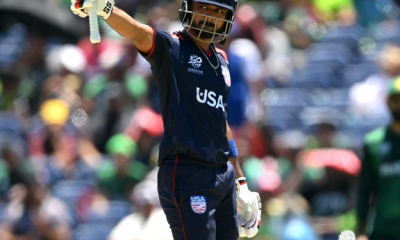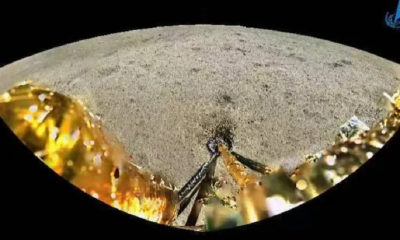Features
In bid to counter China, US ramps up effort to boost military ties in Asia
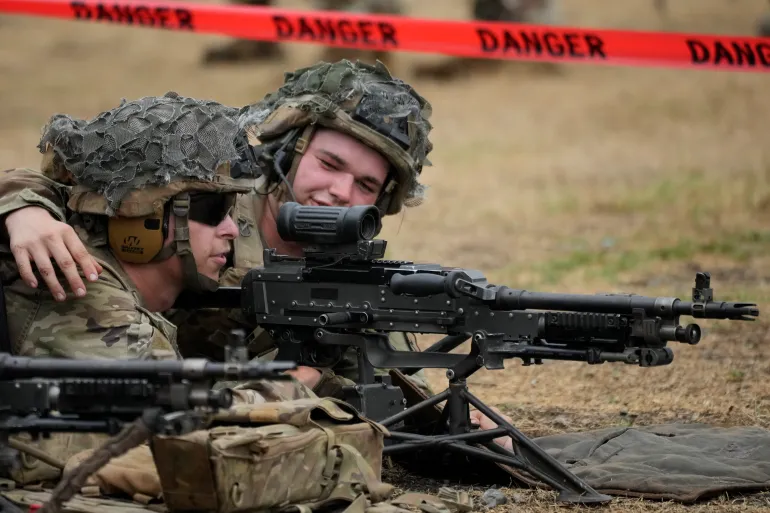
On May 30, the United States accused China of intercepting one of its spy planes in an “unnecessarily aggressive manoeuvre” over the South China Sea. The American RC-135 plane, according to the US military, was conducting routine operations over the sensitive waterway when the Chinese fighter jet flew directly in front of its nose.
A video shared by the US Indo-Pacific Command showed the cockpit of the RC-135 shaking in the wake of turbulence of the Chinese jet.
Days later, on June 5, the US again accused China of carrying out what it said was an ‘unsafe’ manouver near one of its vessels. This time it was around a warship in the Taiwan Strait. The US Indo-Pacific Command again released a video of the incident, showing a Chinese navy vessel cutting sharply across the path of a US destroyer at a distance of some 137 metres (150 yards), forcing the latter to slow down to avoid a collision.
Washington said the near misses showed China’s “growing aggressiveness”, but Beijing said the US was to blame, accusing its rival of deliberately “provoking risk” by sending aircraft and vessels for “close in reconnaissance” near its shores – moves it said posed a serious danger to its national security.
The close calls evoked memories of a deadly incident on April 1, 2001, when a Chinese fighter jet and a US surveillance plane collided in the sky over the South China Sea. The impact caused the Chinese jet to crash and killed the pilot, while the US plane was forced to make an emergency landing in China’s Hainan. Beijing held the 24 American aircrew members for 11 days and only released them when Washington apologised for the incident.
While the two countries were able to de-escalate tensions then, there are worries that a similar mishap today could widen into a bigger conflict due to the deterioration in relations between the rivals.
The US views China as the biggest challenge to the Western-dominated international order, pointing to Beijing’s rapid military buildup – the biggest in peacetime history – as well as its claims over the self-governed island of Taiwan and in the East and South China Seas. The US military’s so-called “freedom of navigation exercises” in the contested waterways near China are part of a push by the administration of President Joe Biden to deepen and expand its diplomatic and military presence in the Asia Pacific.
The campaign – which has accelerated over the past year – stretches from Japan to the Philippines and Australia, and from India to Papua New Guinea and the Solomon Islands. The “once in a generation effort,” as Gregory Poling, director of the Southeast Asia Program at the Center for Strategic and International Studies, puts it, involves the opening of new embassies in the region, deployment of troops and more advanced military assets, as well as obtaining access to sites in key areas facing the South China Sea and the Taiwan Strait.
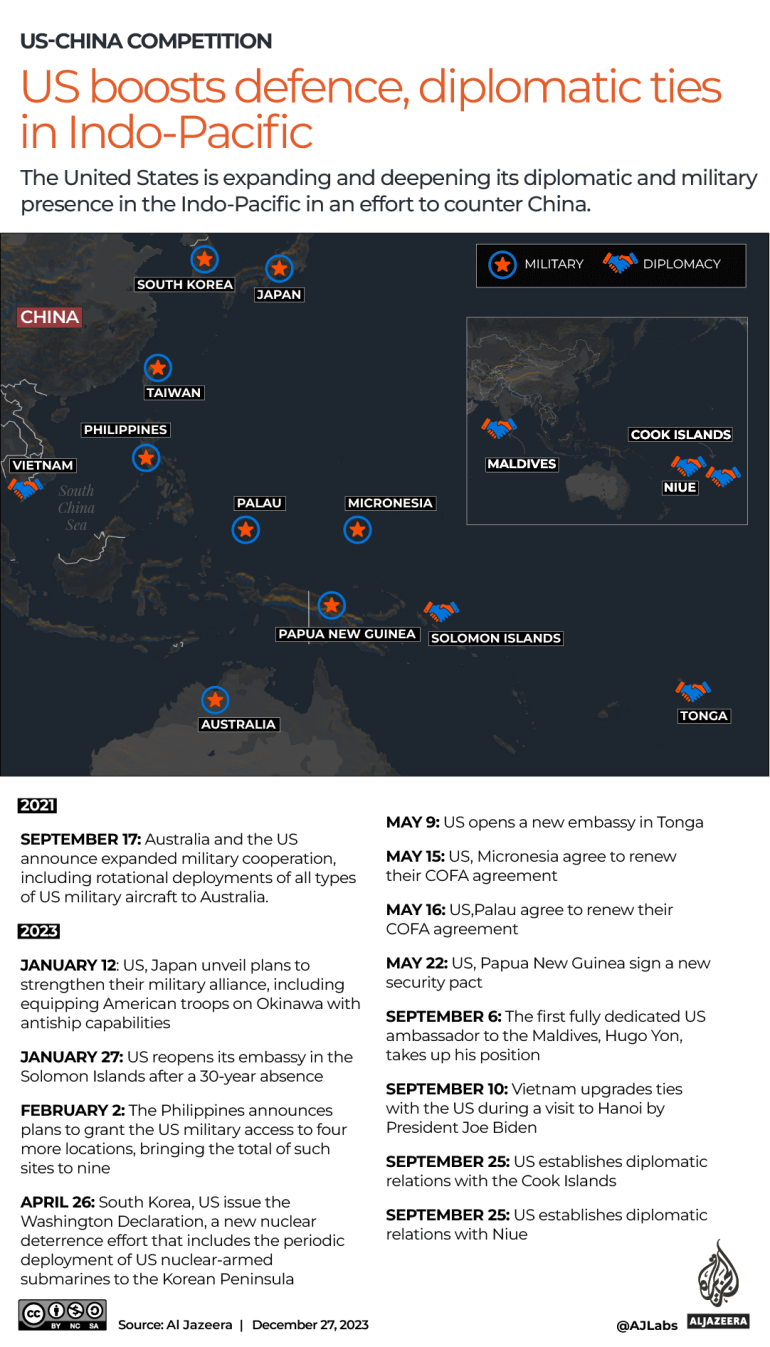
For its part, China accuses the US of pursuing a policy of “containment, encirclement and suppression”, all aimed at holding back its economic development. And its leaders have pledged to resist.
Chinese President Xi Jinping said the US campaign has “brought unprecedented sever challenges to our country’s development”, and in a speech in March called on his countrymen to “dare to fight”. His former Defence Minister Li Shangfu, during an address at the Shangri-La Dialogue in Singapore, condemned what he called Washington’s “Cold War mentality”, and said Beijing would not be intimidated and would “resolutely safeguard national sovereignty and territorial integrity, regardless of any cost”.
Analysts say tensions will only heighten further as competition between China and the US – a contest about who gets to set the rules on the global stage – intensifies. While the superpower rivalry could bring benefits to countries in the Asia Pacific in the short term – particularly in the form of infrastructure loans and foreign direct investments – these nations could, in the future, find having to navigate between China and the US more challenging.
“This is a competition over what the rules-based order looks like, at least in Asia,” Poling told Al Jazeera. “It’s about whether or not the existing global rules continue to apply to Asia or whether China gets to carve out a huge area of exemption in which its preferred rules predominate.
“Clearly, the next couple of decades at least are going to be characterised by this growing competition. Unless China changes its strategy on this … then we’re going to see competition continue to heighten and tensions continue to heighten not just between the US and China, but also between China and most of its neighbours.”
China’s rise
Japan’s defeat in World War II ushered in an age of US dominance in Asia. But in recent decades, China’s growing military and economic might has brought an end to that uncontested primacy.
Under Xi, who took office in 2012 championing what he calls the “Chinese dream of national rejuvenation”, a vision to restore China’s great-power status, Beijing has invested heavily in modernising its military. According to the International Institute for Strategic Studies, a London-based think tank, China has more than doubled its military spending over the past decade, with expenditure reaching $219bn in 2022 although this is still less than a third of US spending during the same year.
China has also embarked on a naval shipbuilding programme that has put more vessels to sea between 2014 and 2018 than the total number of ships in the German, Indian, Spanish and British navies combined. The People’s Liberation Army (PLA) has since also commissioned guided missile cruisers as well as nuclear-powered ballistic missile submarines. In June 2022, it launched its third aircraft carrier, the Fujian. The PLA’s rocket force has also modernised its capabilities, including with the development of hypersonic missiles and anti-ship ballistic missiles. According to the US military, the PLA also plans to accelerate the expansion of its nuclear arsenal to as many as 700 nuclear warheads by 2027 and at least 1,000 by 2030.
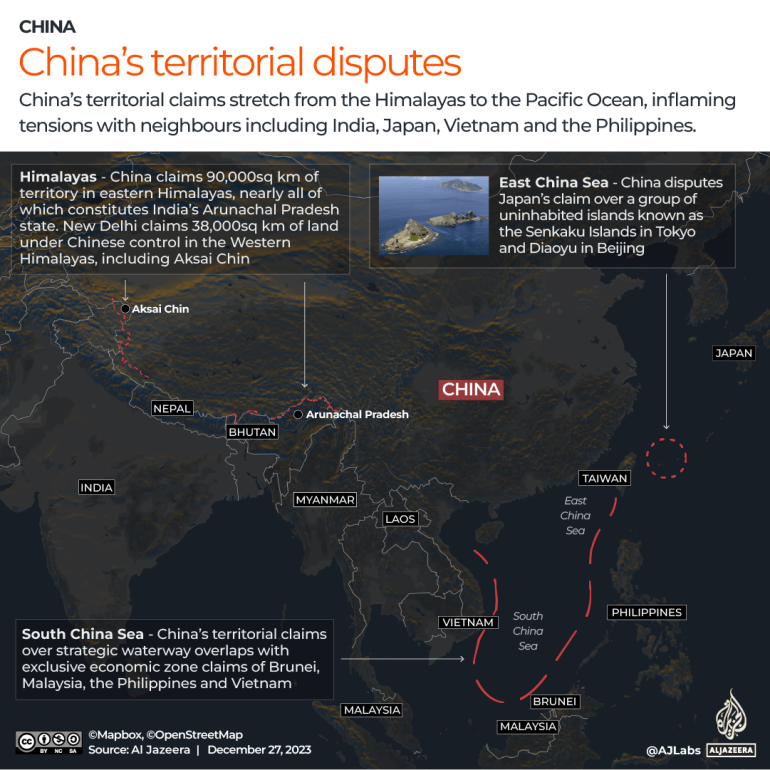
Along with the military build-up, China has also become increasingly assertive in enforcing its territorial claims in crucial waterways off its coast.
In the East China Sea, Beijing lays claim to a group of Japanese-administered islands known as Diaoyu in China and Senkaku in Japan and has increased naval and aerial patrols in the area, drawing protest from Tokyo.
China also lays claim to the entire South China Sea, via its nine-dash line, much to the ire of neighbouring Philippines, Vietnam, Taiwan, Brunei and Malaysia. To shore up those claims, China has built artificial islands in disputed waters, including in the Spratly Islands which it seized from the Philippines in 1996, and expanded its presence in the Paracel Islands which it seized from Vietnam in 1976. China now operates four large outposts with 10,000-foot runways on Woody Island, Fiery Cross Reef, Mischief Reef and Subi Reef. It has also deployed substantial military assets to the islands, including anti-ship missiles, and hangars capable of housing military transport, patrol and combat aircraft.
At the same time, China has faced off with India over their disputed border in the Himalayas. Tensions in the region boiled over in June 2020, when Chinese and Indian troops fought each other with sticks and clubs. At least 20 Indian and four Chinese soldiers died.
Xi has also stepped up rhetoric around Taiwan.
During the Chinese Communist Party’s Congress in September, Xi called unification with the democratically-governed island a “historic mission” and an “unshakable commitment”. The PLA has meanwhile normalised incursions into Taiwan’s Air Defence Identification Zone, the airspace in which Taiwan attempts to identify and control all aircraft.
On the economic front, too, China has grown increasingly powerful.
It is the most important trading partner for more than 120 countries in the world and has sought to expand its economic influence through the ambitious Belt and Road Initiative (BRI). Under the project, sometimes known as the New Silk Road, China has financed physical infrastructure, such as ports, bridges and railways across Asia, Africa and Europe and funded hundreds of special economic zones, or industrial areas designed to create jobs. To date, some 147 countries have signed on to BRI projects or indicated an interest in doing so. In total, China has already disbursed an estimated $1 trillion on such efforts and may spend as much as $8 trillion over the life of the project.
Arc of alliances
The US has sounded the alarm over China’s growing clout.
Biden has called Xi a ‘dictator’, while his administration has accused Beijing of leveraging its commercial, military and technological might to “pursue a sphere of influence in the Indo-Pacific” and “become the world’s most influential power”.
Biden’s Secretary of State Antony Blinken, unveiling the US’s China strategy last year, described the Asian power as “the only country with both the intent to reshape the international order and, increasingly, the economic, diplomatic, military and technological power to do it”.
A key pillar in the US’s campaign to counter China has been its efforts to deepen and expand its military and diplomatic ties with countries in the Indo-Pacific. The campaign – which includes boosting relations with allies such as Australia, Japan and South Korea, and non-allies such as India and Vietnam – has arguably resulted in the most robust US diplomatic and military posture in the Asia Pacific in recent decades.
In Australia, the US, along with the United Kingdom, has announced a historic security partnership to equip Canberra with up to five nuclear-powered attack submarines by the early 2030s. These vessels, which are equipped with long-range missiles, are much harder to detect and can stay underwater far longer than conventional submarines, “making them one of the most effective ways to complicate Chinese military planning and give Beijing a reason to take pause before using force”, according to the Carnegie Endowment for International Peace. Australia and the US have also announced plans to increase the rotational presence of US air, land and sea forces on the island continent, and build airfields to operate nuclear-capable B52 bombers from northern Australia.
In Japan, the US has announced plans to overhaul its troop presence on the Okinawa Islands, including equipping its maritime units there with long-range fire abilities that can hit ships – something that would be key in the event of a Chinese invasion of Taiwan.
In South Korea, which has grown increasingly anxious about neighbouring North Korea’s accelerating nuclear and missile programme, the US has announced new security assurances including the deployment of a nuclear-armed submarine to the Korean peninsula for the first time in four decades. More significantly, the US has announced a new trilateral security partnership with Seoul and Tokyo, a historic achievement given the long history of mutual acrimony between the two countries. At a summit in Camp David in the US in August, the three nations condemned China’s “dangerous and aggressive behaviours” in the South China Sea and pledged to deepen military and economic cooperation to tackle regional challenges.
In the Philippines, another US ally, the government of President Ferdinand Marcos Jr – incensed by Chinese harassment of its vessels in the South China Sea – has granted the Pentagon access to four more sites in the country. This brings to nine the number of locations that US forces have access to in the country – albeit on a rotational basis. Three of the four new sites are in the provinces of Cagayan and Isabela in northern Philippines, facing Taiwan, and the other in eastern Palawan, near the disputed Spratly Islands in the South China Sea. The Philippines and the US have also stepped up the scope and scale of their military exercises, and Washington has reinforced its commitment to defend Manila from an attack at sea. The navies of the two countries are eyeing joint naval patrols in the South China Sea, while the US has also increased freedom of navigation exercises in the waterway.
Vietnam, too, has upgraded its ties with the US. Alarmed by China’s actions in the South China Sea, Hanoi in September elevated the US’s diplomatic status to that of a comprehensive strategic partner – on par with that of China and Russia. The move came during a historic visit to the Vietnamese capital by Biden, and experts say it is indicative of the depth of its concern over its territorial dispute with China in the South China Sea.
On Taiwan, Biden has said on several occasions that the US would come to the island’s aid if there was a Chinese attack. While the White House has since walked back those statements, the Biden administration has continued arms sales to Taiwan, approving more than $3bn in weapons transfers and also allowing US officials to meet more freely with Taiwanese counterparts.
In the Pacific Islands, too, the US has expanded its military and diplomatic footprint.
In May, it signed a security deal with Papua New Guinea that gives it “unimpeded access” to several key airports and seaports in the Pacific nation and re-opened an embassy in the Solomon Islands after a 30-year absence. It has also opened an embassy in Tonga and is in talks with Kiribati and Vanuatu to establish a diplomatic presence there. Biden has also hosted historic summits for Pacific Island leaders in Washington, DC, pledging $810m in new aid for the Pacific Islands over the next decade, including to tackle the existential threat of climate change.
Non-aligned India, too, has stepped up cooperation with the US.
The two countries, along with Australia and Japan have revived an informal alliance known as the Quadrilateral Security Dialogue, or Quad, in a bid to counter China and deliver public goods to countries in the Global South. Quad pledges include a key initiative to help countries protect maritime resources from predatory illegal fishing and promises to invest more than $50bn in developing infrastructure in the Indo-Pacific.
‘Desperation’
Analysts say the US campaign has stirred anger and concern in Beijing.
“This latest phase really just shows an increase in desperation on the part of the US because taking military measures usually is a last resort. Because it’s risky and it’s expensive. It’s also very dangerous. A country that has to resort to these measures, I think, clearly feels it is running out of options and is increasingly desperate to protect its rapidly eroding position in the world,” said Andy Mok, senior research fellow at the Center for China and Globalization in Beijing.
“We only need to look at a map of US military assets to see who’s the aggressor. It’s not that China has numerous military bases surrounding the United States. It’s exactly the opposite. So I think any reasonable observer would question this assertion whether China is really engaging in any sort of military provocations here.”
Mok said China is responding to the US’s efforts by continuing its military modernisation as well as strengthening its own ties.
The military modernisation efforts “include everything from the development of hypersonic missiles to a much stronger navy that is effective not just close to China’s shores, which would include Taiwan, of course, but much broader,” he said. “It includes cyber, includes space from the military perspective. So, becoming a much more comprehensive military force able to respond to threats a number of different ways.”
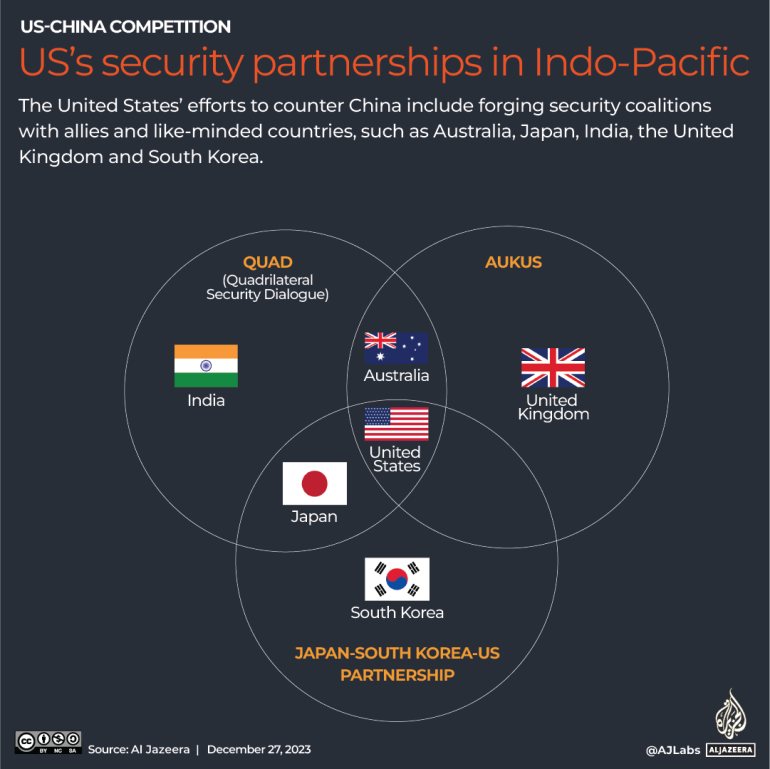
On the diplomatic front, Mok said China will look to strengthen multilateral initiatives such as the Regional Comprehensive Economic Partnership, the world’s largest free trade agreement that brings together 15 countries, the BRICs group that includes Brazil, Russia and India, and the Shanghai Cooperation Organization (SCO), a nine-member Eurasian group that counts Pakistan and Iran among its members.
“These are all attempts to create a more humane and just global order, where these types of issues are, again, not decided by one country and not decided through coercion, whether that’s primarily military coercion or other forms of coercion, including economic sanctions,” he added.
Heightened tensions
For countries in the Asia Pacific, especially in Southeast Asia, the increased US-China competition has brought some economic benefits. To compete with China’s BRI, the US has pledged to step up investment in infrastructure, though much of this investment has yet to bear fruit, while the trade war between the superpowers has resulted in some Southeast Asian countries marketing themselves as alternative production destinations.
“In Southeast Asia, I think the emphasis is on autonomy. And to the extent that they can invite more actors in to have a stake – whether this is the United States, whether this is Korea, Japan, the EU or Australia – that is somewhat more preferred because it dilutes the presence of any single actor,” said Ja-Ian Chong, associate professor at the National University of Singapore.
“With the diversification of investment from the United States, South Korea, Japan, Taiwan, Australia, some Southeast Asian states will be big beneficiaries. So Vietnam, Thailand, Indonesia, and to some degree, the Philippines and Malaysia have seen investment that might otherwise go to China go to them.”
China, Chong said, sees the robustness of US presence in the region as a bit of a challenge.
“The question is, how they will respond? It is possible that they may respond with more caution, which could be stabilising, but there’s also a possibility that they could react even more strongly. But that’s not easy to predict at this point in time.”
So far, it appears that Beijing is seeking to contest the US’s presence.
That is evident not just in the confrontations between US and Chinese vessels and aircraft over the South China Sea and the Taiwan Strait, but also in Beijing’s standoffs with Philippine military boats in the South China Sea. These include incidents in August and earlier this month when the Chinese Coast Guard used water cannon to prevent the Philippine military from resupplying its troops living on a grounded warship on the disputed Second Thomas Shoal.
On Taiwan, too, China’s navy this year launched its largest-ever exercises in the Pacific Ocean, deploying an aircraft carrier and dozens of naval ships and warplanes, in a move analysts said was probably practice for enforcing a blockade around the island. Beijing said the purpose of the drills was to “resolutely combat the arrogance of Taiwan independence separatist forces and their actions to seek independence”.
Chong said the tensions were likely to pose new challenges to countries in the region.
“I expect the contestation to become more intense. Meaning to say that trying to navigate between the two major powers will become more challenging, not impossible, but certainly more challenging. To expect that you can act in ways that get benefits from both sides may become more difficult. It may be the case that working with one more will invite pressure from the other,” said Chong. “That is likely to be a challenge facing Southeast Asia unless they are more able to set up their own direction.”
(Aljazeera)
Features
The heart-friendly health minister

by Dr Gotabhya Ranasinghe
Senior Consultant Cardiologist
National Hospital Sri Lanka
When we sought a meeting with Hon Dr. Ramesh Pathirana, Minister of Health, he graciously cleared his busy schedule to accommodate us. Renowned for his attentive listening and deep understanding, Minister Pathirana is dedicated to advancing the health sector. His openness and transparency exemplify the qualities of an exemplary politician and minister.
Dr. Palitha Mahipala, the current Health Secretary, demonstrates both commendable enthusiasm and unwavering support. This combination of attributes makes him a highly compatible colleague for the esteemed Minister of Health.
Our discussion centered on a project that has been in the works for the past 30 years, one that no other minister had managed to advance.
Minister Pathirana, however, recognized the project’s significance and its potential to revolutionize care for heart patients.
The project involves the construction of a state-of-the-art facility at the premises of the National Hospital Colombo. The project’s location within the premises of the National Hospital underscores its importance and relevance to the healthcare infrastructure of the nation.
This facility will include a cardiology building and a tertiary care center, equipped with the latest technology to handle and treat all types of heart-related conditions and surgeries.
Securing funding was a major milestone for this initiative. Minister Pathirana successfully obtained approval for a $40 billion loan from the Asian Development Bank. With the funding in place, the foundation stone is scheduled to be laid in September this year, and construction will begin in January 2025.
This project guarantees a consistent and uninterrupted supply of stents and related medications for heart patients. As a result, patients will have timely access to essential medical supplies during their treatment and recovery. By securing these critical resources, the project aims to enhance patient outcomes, minimize treatment delays, and maintain the highest standards of cardiac care.
Upon its fruition, this monumental building will serve as a beacon of hope and healing, symbolizing the unwavering dedication to improving patient outcomes and fostering a healthier society.We anticipate a future marked by significant progress and positive outcomes in Sri Lanka’s cardiovascular treatment landscape within the foreseeable timeframe.
Features
A LOVING TRIBUTE TO JESUIT FR. ALOYSIUS PIERIS ON HIS 90th BIRTHDAY

by Fr. Emmanuel Fernando, OMI
Jesuit Fr. Aloysius Pieris (affectionately called Fr. Aloy) celebrated his 90th birthday on April 9, 2024 and I, as the editor of our Oblate Journal, THE MISSIONARY OBLATE had gone to press by that time. Immediately I decided to publish an article, appreciating the untiring selfless services he continues to offer for inter-Faith dialogue, the renewal of the Catholic Church, his concern for the poor and the suffering Sri Lankan masses and to me, the present writer.
It was in 1988, when I was appointed Director of the Oblate Scholastics at Ampitiya by the then Oblate Provincial Fr. Anselm Silva, that I came to know Fr. Aloy more closely. Knowing well his expertise in matters spiritual, theological, Indological and pastoral, and with the collaborative spirit of my companion-formators, our Oblate Scholastics were sent to Tulana, the Research and Encounter Centre, Kelaniya, of which he is the Founder-Director, for ‘exposure-programmes’ on matters spiritual, biblical, theological and pastoral. Some of these dimensions according to my view and that of my companion-formators, were not available at the National Seminary, Ampitiya.
Ever since that time, our Oblate formators/ accompaniers at the Oblate Scholasticate, Ampitiya , have continued to send our Oblate Scholastics to Tulana Centre for deepening their insights and convictions regarding matters needed to serve the people in today’s context. Fr. Aloy also had tried very enthusiastically with the Oblate team headed by Frs. Oswald Firth and Clement Waidyasekara to begin a Theologate, directed by the Religious Congregations in Sri Lanka, for the contextual formation/ accompaniment of their members. It should very well be a desired goal of the Leaders / Provincials of the Religious Congregations.
Besides being a formator/accompanier at the Oblate Scholasticate, I was entrusted also with the task of editing and publishing our Oblate journal, ‘The Missionary Oblate’. To maintain the quality of the journal I continue to depend on Fr. Aloy for his thought-provoking and stimulating articles on Biblical Spirituality, Biblical Theology and Ecclesiology. I am very grateful to him for his generous assistance. Of late, his writings on renewal of the Church, initiated by Pope St. John XX111 and continued by Pope Francis through the Synodal path, published in our Oblate journal, enable our readers to focus their attention also on the needed renewal in the Catholic Church in Sri Lanka. Fr. Aloy appreciated very much the Synodal path adopted by the Jesuit Pope Francis for the renewal of the Church, rooted very much on prayerful discernment. In my Religious and presbyteral life, Fr.Aloy continues to be my spiritual animator / guide and ongoing formator / acccompanier.
Fr. Aloysius Pieris, BA Hons (Lond), LPh (SHC, India), STL (PFT, Naples), PhD (SLU/VC), ThD (Tilburg), D.Ltt (KU), has been one of the eminent Asian theologians well recognized internationally and one who has lectured and held visiting chairs in many universities both in the West and in the East. Many members of Religious Congregations from Asian countries have benefited from his lectures and guidance in the East Asian Pastoral Institute (EAPI) in Manila, Philippines. He had been a Theologian consulted by the Federation of Asian Bishops’ Conferences for many years. During his professorship at the Gregorian University in Rome, he was called to be a member of a special group of advisers on other religions consulted by Pope Paul VI.
Fr. Aloy is the author of more than 30 books and well over 500 Research Papers. Some of his books and articles have been translated and published in several countries. Among those books, one can find the following: 1) The Genesis of an Asian Theology of Liberation (An Autobiographical Excursus on the Art of Theologising in Asia, 2) An Asian Theology of Liberation, 3) Providential Timeliness of Vatican 11 (a long-overdue halt to a scandalous millennium, 4) Give Vatican 11 a chance, 5) Leadership in the Church, 6) Relishing our faith in working for justice (Themes for study and discussion), 7) A Message meant mainly, not exclusively for Jesuits (Background information necessary for helping Francis renew the Church), 8) Lent in Lanka (Reflections and Resolutions, 9) Love meets wisdom (A Christian Experience of Buddhism, 10) Fire and Water 11) God’s Reign for God’s poor, 12) Our Unhiddden Agenda (How we Jesuits work, pray and form our men). He is also the Editor of two journals, Vagdevi, Journal of Religious Reflection and Dialogue, New Series.
Fr. Aloy has a BA in Pali and Sanskrit from the University of London and a Ph.D in Buddhist Philosophy from the University of Sri Lankan, Vidyodaya Campus. On Nov. 23, 2019, he was awarded the prestigious honorary Doctorate of Literature (D.Litt) by the Chancellor of the University of Kelaniya, the Most Venerable Welamitiyawe Dharmakirthi Sri Kusala Dhamma Thera.
Fr. Aloy continues to be a promoter of Gospel values and virtues. Justice as a constitutive dimension of love and social concern for the downtrodden masses are very much noted in his life and work. He had very much appreciated the commitment of the late Fr. Joseph (Joe) Fernando, the National Director of the Social and Economic Centre (SEDEC) for the poor.
In Sri Lanka, a few religious Congregations – the Good Shepherd Sisters, the Christian Brothers, the Marist Brothers and the Oblates – have invited him to animate their members especially during their Provincial Congresses, Chapters and International Conferences. The mainline Christian Churches also have sought his advice and followed his seminars. I, for one, regret very much, that the Sri Lankan authorities of the Catholic Church –today’s Hierarchy—- have not sought Fr.
Aloy’s expertise for the renewal of the Catholic Church in Sri Lanka and thus have not benefited from the immense store of wisdom and insight that he can offer to our local Church while the Sri Lankan bishops who governed the Catholic church in the immediate aftermath of the Second Vatican Council (Edmund Fernando OMI, Anthony de Saram, Leo Nanayakkara OSB, Frank Marcus Fernando, Paul Perera,) visited him and consulted him on many matters. Among the Tamil Bishops, Bishop Rayappu Joseph was keeping close contact with him and Bishop J. Deogupillai hosted him and his team visiting him after the horrible Black July massacre of Tamils.
Features
A fairy tale, success or debacle

Sri Lanka-Singapore Free Trade Agreement
By Gomi Senadhira
senadhiragomi@gmail.com
“You might tell fairy tales, but the progress of a country cannot be achieved through such narratives. A country cannot be developed by making false promises. The country moved backward because of the electoral promises made by political parties throughout time. We have witnessed that the ultimate result of this is the country becoming bankrupt. Unfortunately, many segments of the population have not come to realize this yet.” – President Ranil Wickremesinghe, 2024 Budget speech
Any Sri Lankan would agree with the above words of President Wickremesinghe on the false promises our politicians and officials make and the fairy tales they narrate which bankrupted this country. So, to understand this, let’s look at one such fairy tale with lots of false promises; Ranil Wickremesinghe’s greatest achievement in the area of international trade and investment promotion during the Yahapalana period, Sri Lanka-Singapore Free Trade Agreement (SLSFTA).
It is appropriate and timely to do it now as Finance Minister Wickremesinghe has just presented to parliament a bill on the National Policy on Economic Transformation which includes the establishment of an Office for International Trade and the Sri Lanka Institute of Economics and International Trade.
Was SLSFTA a “Cleverly negotiated Free Trade Agreement” as stated by the (former) Minister of Development Strategies and International Trade Malik Samarawickrama during the Parliamentary Debate on the SLSFTA in July 2018, or a colossal blunder covered up with lies, false promises, and fairy tales? After SLSFTA was signed there were a number of fairy tales published on this agreement by the Ministry of Development Strategies and International, Institute of Policy Studies, and others.
However, for this article, I would like to limit my comments to the speech by Minister Samarawickrama during the Parliamentary Debate, and the two most important areas in the agreement which were covered up with lies, fairy tales, and false promises, namely: revenue loss for Sri Lanka and Investment from Singapore. On the other important area, “Waste products dumping” I do not want to comment here as I have written extensively on the issue.
1. The revenue loss
During the Parliamentary Debate in July 2018, Minister Samarawickrama stated “…. let me reiterate that this FTA with Singapore has been very cleverly negotiated by us…. The liberalisation programme under this FTA has been carefully designed to have the least impact on domestic industry and revenue collection. We have included all revenue sensitive items in the negative list of items which will not be subject to removal of tariff. Therefore, 97.8% revenue from Customs duty is protected. Our tariff liberalisation will take place over a period of 12-15 years! In fact, the revenue earned through tariffs on goods imported from Singapore last year was Rs. 35 billion.
The revenue loss for over the next 15 years due to the FTA is only Rs. 733 million– which when annualised, on average, is just Rs. 51 million. That is just 0.14% per year! So anyone who claims the Singapore FTA causes revenue loss to the Government cannot do basic arithmetic! Mr. Speaker, in conclusion, I call on my fellow members of this House – don’t mislead the public with baseless criticism that is not grounded in facts. Don’t look at petty politics and use these issues for your own political survival.”
I was surprised to read the minister’s speech because an article published in January 2018 in “The Straits Times“, based on information released by the Singaporean Negotiators stated, “…. With the FTA, tariff savings for Singapore exports are estimated to hit $10 million annually“.
As the annual tariff savings (that is the revenue loss for Sri Lanka) calculated by the Singaporean Negotiators, Singaporean $ 10 million (Sri Lankan rupees 1,200 million in 2018) was way above the rupees’ 733 million revenue loss for 15 years estimated by the Sri Lankan negotiators, it was clear to any observer that one of the parties to the agreement had not done the basic arithmetic!
Six years later, according to a report published by “The Morning” newspaper, speaking at the Committee on Public Finance (COPF) on 7th May 2024, Mr Samarawickrama’s chief trade negotiator K.J. Weerasinghehad had admitted “…. that forecasted revenue loss for the Government of Sri Lanka through the Singapore FTA is Rs. 450 million in 2023 and Rs. 1.3 billion in 2024.”
If these numbers are correct, as tariff liberalisation under the SLSFTA has just started, we will pass Rs 2 billion very soon. Then, the question is how Sri Lanka’s trade negotiators made such a colossal blunder. Didn’t they do their basic arithmetic? If they didn’t know how to do basic arithmetic they should have at least done their basic readings. For example, the headline of the article published in The Straits Times in January 2018 was “Singapore, Sri Lanka sign FTA, annual savings of $10m expected”.
Anyway, as Sri Lanka’s chief negotiator reiterated at the COPF meeting that “…. since 99% of the tariffs in Singapore have zero rates of duty, Sri Lanka has agreed on 80% tariff liberalisation over a period of 15 years while expecting Singapore investments to address the imbalance in trade,” let’s turn towards investment.
Investment from Singapore
In July 2018, speaking during the Parliamentary Debate on the FTA this is what Minister Malik Samarawickrama stated on investment from Singapore, “Already, thanks to this FTA, in just the past two-and-a-half months since the agreement came into effect we have received a proposal from Singapore for investment amounting to $ 14.8 billion in an oil refinery for export of petroleum products. In addition, we have proposals for a steel manufacturing plant for exports ($ 1 billion investment), flour milling plant ($ 50 million), sugar refinery ($ 200 million). This adds up to more than $ 16.05 billion in the pipeline on these projects alone.
And all of these projects will create thousands of more jobs for our people. In principle approval has already been granted by the BOI and the investors are awaiting the release of land the environmental approvals to commence the project.
I request the Opposition and those with vested interests to change their narrow-minded thinking and join us to develop our country. We must always look at what is best for the whole community, not just the few who may oppose. We owe it to our people to courageously take decisions that will change their lives for the better.”
According to the media report I quoted earlier, speaking at the Committee on Public Finance (COPF) Chief Negotiator Weerasinghe has admitted that Sri Lanka was not happy with overall Singapore investments that have come in the past few years in return for the trade liberalisation under the Singapore-Sri Lanka Free Trade Agreement. He has added that between 2021 and 2023 the total investment from Singapore had been around $162 million!
What happened to those projects worth $16 billion negotiated, thanks to the SLSFTA, in just the two-and-a-half months after the agreement came into effect and approved by the BOI? I do not know about the steel manufacturing plant for exports ($ 1 billion investment), flour milling plant ($ 50 million) and sugar refinery ($ 200 million).
However, story of the multibillion-dollar investment in the Petroleum Refinery unfolded in a manner that would qualify it as the best fairy tale with false promises presented by our politicians and the officials, prior to 2019 elections.
Though many Sri Lankans got to know, through the media which repeatedly highlighted a plethora of issues surrounding the project and the questionable credentials of the Singaporean investor, the construction work on the Mirrijiwela Oil Refinery along with the cement factory began on the24th of March 2019 with a bang and Minister Ranil Wickremesinghe and his ministers along with the foreign and local dignitaries laid the foundation stones.
That was few months before the 2019 Presidential elections. Inaugurating the construction work Prime Minister Ranil Wickremesinghe said the projects will create thousands of job opportunities in the area and surrounding districts.
The oil refinery, which was to be built over 200 acres of land, with the capacity to refine 200,000 barrels of crude oil per day, was to generate US$7 billion of exports and create 1,500 direct and 3,000 indirect jobs. The construction of the refinery was to be completed in 44 months. Four years later, in August 2023 the Cabinet of Ministers approved the proposal presented by President Ranil Wickremesinghe to cancel the agreement with the investors of the refinery as the project has not been implemented! Can they explain to the country how much money was wasted to produce that fairy tale?
It is obvious that the President, ministers, and officials had made huge blunders and had deliberately misled the public and the parliament on the revenue loss and potential investment from SLSFTA with fairy tales and false promises.
As the president himself said, a country cannot be developed by making false promises or with fairy tales and these false promises and fairy tales had bankrupted the country. “Unfortunately, many segments of the population have not come to realize this yet”.
(The writer, a specialist and an activist on trade and development issues . )


